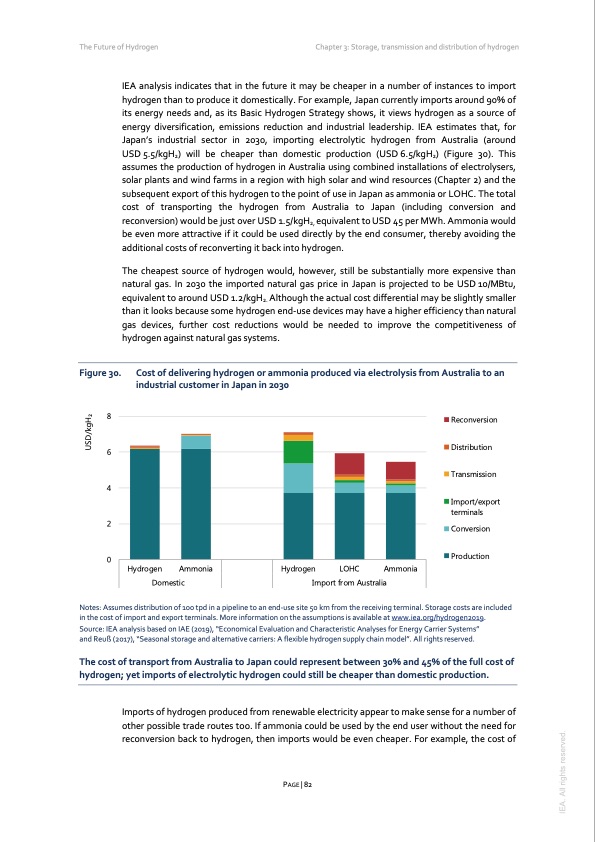
PDF Publication Title:
Text from PDF Page: 082
The Future of Hydrogen Chapter 3: Storage, transmission and distribution of hydrogen Figure 30. 8 6 4 2 0 IEA analysis indicates that in the future it may be cheaper in a number of instances to import hydrogen than to produce it domestically. For example, Japan currently imports around 90% of its energy needs and, as its Basic Hydrogen Strategy shows, it views hydrogen as a source of energy diversification, emissions reduction and industrial leadership. IEA estimates that, for Japan’s industrial sector in 2030, importing electrolytic hydrogen from Australia (around USD 5.5/kgH2) will be cheaper than domestic production (USD 6.5/kgH2) (Figure 30). This assumes the production of hydrogen in Australia using combined installations of electrolysers, solar plants and wind farms in a region with high solar and wind resources (Chapter 2) and the subsequent export of this hydrogen to the point of use in Japan as ammonia or LOHC. The total cost of transporting the hydrogen from Australia to Japan (including conversion and reconversion) would be just over USD 1.5/kgH2, equivalent to USD 45 per MWh. Ammonia would be even more attractive if it could be used directly by the end consumer, thereby avoiding the additional costs of reconverting it back into hydrogen. The cheapest source of hydrogen would, however, still be substantially more expensive than natural gas. In 2030 the imported natural gas price in Japan is projected to be USD 10/MBtu, equivalent to around USD 1.2/kgH2. Although the actual cost differential may be slightly smaller than it looks because some hydrogen end-use devices may have a higher efficiency than natural gas devices, further cost reductions would be needed to improve the competitiveness of hydrogen against natural gas systems. Cost of delivering hydrogen or ammonia produced via electrolysis from Australia to an industrial customer in Japan in 2030 Hydrogen Domestic Ammonia Ammonia Hydrogen LOHC Import from Australia Notes: Assumes distribution of 100 tpd in a pipeline to an end-use site 50 km from the receiving terminal. Storage costs are included in the cost of import and export terminals. More information on the assumptions is available at www.iea.org/hydrogen2019. Source: IEA analysis based on IAE (2019), “Economical Evaluation and Characteristic Analyses for Energy Carrier Systems” and Reuß (2017), “Seasonal storage and alternative carriers: A flexible hydrogen supply chain model”. All rights reserved. The cost of transport from Australia to Japan could represent between 30% and 45% of the full cost of hydrogen; yet imports of electrolytic hydrogen could still be cheaper than domestic production. Imports of hydrogen produced from renewable electricity appear to make sense for a number of other possible trade routes too. If ammonia could be used by the end user without the need for reconversion back to hydrogen, then imports would be even cheaper. For example, the cost of Reconversion Distribution Transmission Import/export terminals Conversion Production PAGE | 82 IEA. All rights reserved. USD/kgH2PDF Image | The Future of Hydrogen 2019

PDF Search Title:
The Future of Hydrogen 2019Original File Name Searched:
the_future_of_hydrogen.pdfDIY PDF Search: Google It | Yahoo | Bing
NFT (Non Fungible Token): Buy our tech, design, development or system NFT and become part of our tech NFT network... More Info
IT XR Project Redstone NFT Available for Sale: NFT for high tech turbine design with one part 3D printed counter-rotating energy turbine. Be part of the future with this NFT. Can be bought and sold but only one design NFT exists. Royalties go to the developer (Infinity) to keep enhancing design and applications... More Info
Infinity Turbine IT XR Project Redstone Design: NFT for sale... NFT for high tech turbine design with one part 3D printed counter-rotating energy turbine. Includes all rights to this turbine design, including license for Fluid Handling Block I and II for the turbine assembly and housing. The NFT includes the blueprints (cad/cam), revenue streams, and all future development of the IT XR Project Redstone... More Info
Infinity Turbine ROT Radial Outflow Turbine 24 Design and Worldwide Rights: NFT for sale... NFT for the ROT 24 energy turbine. Be part of the future with this NFT. This design can be bought and sold but only one design NFT exists. You may manufacture the unit, or get the revenues from its sale from Infinity Turbine. Royalties go to the developer (Infinity) to keep enhancing design and applications... More Info
Infinity Supercritical CO2 10 Liter Extractor Design and Worldwide Rights: The Infinity Supercritical 10L CO2 extractor is for botanical oil extraction, which is rich in terpenes and can produce shelf ready full spectrum oil. With over 5 years of development, this industry leader mature extractor machine has been sold since 2015 and is part of many profitable businesses. The process can also be used for electrowinning, e-waste recycling, and lithium battery recycling, gold mining electronic wastes, precious metals. CO2 can also be used in a reverse fuel cell with nafion to make a gas-to-liquids fuel, such as methanol, ethanol and butanol or ethylene. Supercritical CO2 has also been used for treating nafion to make it more effective catalyst. This NFT is for the purchase of worldwide rights which includes the design. More Info
NFT (Non Fungible Token): Buy our tech, design, development or system NFT and become part of our tech NFT network... More Info
Infinity Turbine Products: Special for this month, any plans are $10,000 for complete Cad/Cam blueprints. License is for one build. Try before you buy a production license. May pay by Bitcoin or other Crypto. Products Page... More Info
| CONTACT TEL: 608-238-6001 Email: greg@infinityturbine.com | RSS | AMP |